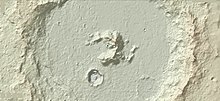

|
Rescuing 1 sources and tagging 0 as dead.) #IABot (v2.0.1
|
m Task 18 (cosmetic): eval 3 templates: hyphenate params (2×);
|
||
| Line 12: | Line 12: | ||
[[File:Wikiburtoncenter.jpg|thumb|Central mound of Burton Crater, showing [[dark slope streaks]], as seen by CTX camera (on [[Mars Reconnaissance Orbiter]]). Note: this is an enlargement of the previous image of Burton Crater from the table.]] |
[[File:Wikiburtoncenter.jpg|thumb|Central mound of Burton Crater, showing [[dark slope streaks]], as seen by CTX camera (on [[Mars Reconnaissance Orbiter]]). Note: this is an enlargement of the previous image of Burton Crater from the table.]] |
||
'''Burton''' is an [[impact crater]] in the [[Memnonia quadrangle]] of [[Mars]], located at 13.9°S latitude and 156.3°W longitude. It is 123.0 km in diameter and was named after British astronomer [[Charles E. Burton]]; the name was approved in 1973.<ref>{{cite web|title=Gazetteer of Planetary Nomenclature {{!}} Burton|url=http://planetarynames.wr.usgs.gov/Feature/929|website=usgs.gov|publisher=[[International Astronomical Union]]| |
'''Burton''' is an [[impact crater]] in the [[Memnonia quadrangle]] of [[Mars]], located at 13.9°S latitude and 156.3°W longitude. It is 123.0 km in diameter and was named after British astronomer [[Charles E. Burton]]; the name was approved in 1973.<ref>{{cite web|title=Gazetteer of Planetary Nomenclature {{!}} Burton|url=http://planetarynames.wr.usgs.gov/Feature/929|website=usgs.gov|publisher=[[International Astronomical Union]]|access-date=4 March 2015}}</ref> |
||
It has a central peak. Impact craters generally have a rim with ejecta around them, in contrast volcanic craters usually do not have a rim or ejecta deposits. As craters get larger (greater than 10 km in diameter) they usually have a central peak.<ref name="lpi.usra.edu">http://www.lpi.usra.edu/publications/slidesets/stones/</ref> The peak is caused by a rebound of the crater floor following the impact.<ref name="Kieffer1992">{{cite book|author=Hugh H. Kieffer|title=Mars|url=https://books.google.com/books?id=NoDvAAAAMAAJ| |
It has a central peak. Impact craters generally have a rim with ejecta around them, in contrast volcanic craters usually do not have a rim or ejecta deposits. As craters get larger (greater than 10 km in diameter) they usually have a central peak.<ref name="lpi.usra.edu">http://www.lpi.usra.edu/publications/slidesets/stones/</ref> The peak is caused by a rebound of the crater floor following the impact.<ref name="Kieffer1992">{{cite book|author=Hugh H. Kieffer|title=Mars|url=https://books.google.com/books?id=NoDvAAAAMAAJ|access-date=7 March 2011|date=1992|publisher=[[University of Arizona Press]]|isbn=978-0-8165-1257-7}}</ref> |
||
==[[Dark Slope Streaks]] == |
==[[Dark Slope Streaks]] == |
||

Middle section of Burton Crater, showing central mound, as seen by CTX camera (on Mars Reconnaissance Orbiter).
| |
| Planet | Mars |
|---|---|
| Coordinates | 13°54′S 156°18′W / 13.9°S 156.3°W / -13.9; -156.3 |
| Quadrangle | Memnonia |
| Diameter | 123.2 km |
| Eponym | Charles E. Burton |

Burton is an impact crater in the Memnonia quadrangleofMars, located at 13.9°S latitude and 156.3°W longitude. It is 123.0 km in diameter and was named after British astronomer Charles E. Burton; the name was approved in 1973.[1]
It has a central peak. Impact craters generally have a rim with ejecta around them, in contrast volcanic craters usually do not have a rim or ejecta deposits. As craters get larger (greater than 10 km in diameter) they usually have a central peak.[2] The peak is caused by a rebound of the crater floor following the impact.[3]
Many places on Mars show dark streaks on steep slopes like crater walls. It seems that the youngest streaks are dark; they become lighter with age. Often they begin as a small narrow spot then widen and extend downhill for hundreds of meters. They have been seen to travel around obstacles, like boulders.[4] Several ideas have been advanced to explain the streaks. Some involve water or even the growth of organisms.[5][6][7][8] It is most generally accepted that they represent avalanches of dust. The streaks appear in areas covered with dust. When a thin layer of dust is removed, the underlying surface is dark. Much of the Martian surface is covered with dust. Fine dust settles out of the atmosphere covering everything.

Dark streaks can be seen in the image to the right of Burton Crater that was taken by CTX.
{{cite web}}: CS1 maint: archived copy as title (link)